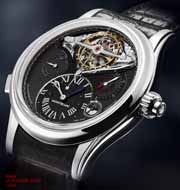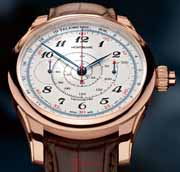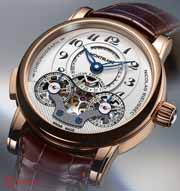

Montblanc
Les nouveautés 2010 des montres Montblanc (On en parle sur le forum)
Chronographe ExoTourbillon
Le nouveau Chronographe ExoTourbillon est un garde-temps de type régulateur, avec une grande aiguille des minutes au centre, un affichage distinct des heures, un second fuseau horaire complété d’une indication jour/nuit, une petite seconde, un chronographe avec compteur 30 minutes et un tourbillon sous une forme qui n’a jamais existé auparavant : son balancier est plus grand que la cage et il est situé hors de celle-ci.
Le balancier a été déplacé hors de la cage tournante afin d’isoler ce dernier des mouvements perturbateurs de l’échappement. Cette séparation a rendu possible la création du premier tourbillon au monde dont la cage tournante est plus petite que le balancier, qui oscille sur un niveau supérieur à l’extérieur de la cage.
Cette singularité de construction explique également le nom de la montre qui provient du grec exo = extérieur. Dans cette configuration hors du commun, le balancier pivote entre 2 amortisseurs alors que la cage pivote indépendamment entre deux pierres.
The new ExoTourbillon Chronographe is a regulator watch with a large centrally axial minute-hand, a distinct hour display, an indicator for the time in a second time zone (with day/night display), a subdial for the seconds, a chronograph with a counter for 30 elapsed minutes, and an absolutely unprecedented tourbillon with a balance larger than the tourbillon’s rotating cage and positioned outside it.
This clever mechanism underwent further optimization for the ExoTourbillon Chronographe: the balance has been separated from the cage to isolate it from the disturbing movements of the escapement.
This separation made it possible to create the world’s first tourbillon in which the rotating cage is smaller than the balance, which oscillates outside the cage and on a higher plane. This architecture also inspired the watch’s name, which includes the Greek prefix exo, meaning outside.
The balance in this unconventional configuration is borne between two jewels - it is neither cantilevered (“flying”) nor is it borne between two bridges - while the tourbillon turns at the foot of the axis in a two-point bearing.
Chronographe Vintage
Avec son cadran caractéristique aux différentes échelles, le Chronographe Vintage est l’instrument par excellence pour mesurer de brefs intervalles de temps.
Seulement les innovations les plus importantes au passé peuvent devenir les traditions d`aujourd`hui – et méritent l`appellation « vintage ». Et il en va de même pour le nouveau chronographe de la collection Villeret 1858 de Montblanc, avec l’échelle de tachymètre en spirale au centre du cadran. Cette disposition reprend une caractéristique emblématique adoptée par les légendaires chronographes Minerva au cours des années 1910 et 1930.
Comme le pourtour du cadran était réservé au télémètre, l’échelle du tachymètre était déplacée au centre et adoptait une forme en colimaçon afin de présenter la longueur nécessaire pour calculer des vitesses sur une durée de trois minutes.
Sous le cadran, le légendaire calibre Minerva MBM 16.29 remplit fidèlement sa mission avec toutes les caractéristiques qui font battre plus fort le cœur d’un véritable amateur d’horlogerie : un imposant balancier à vis et une fréquence de 18'000 alternances par heure (2,5 Hertz), un spiral avec courbe terminale Phillips, un mécanisme de réglage de précision, des ponts de chronographe en forme de V et des aciers chronographe minutieusement anglés et finis à la main, un embrayage horizontal classique et la roue à colonnes pour commander les fonctions (du chronographe).
With its unmistakable dial, which emphasizes finely calibrated scales, the Vintage Chronographe is a superlative device for the measurement of brief intervals of time.
Only the most powerful innovations of the past can become the traditions of today – and are awarded the appellation “vintage”.
The same applies to this new chronograph in the Montblanc Collection Villeret 1858, which boasts a spirally shaped tachymeter scale in the center of its dial.
A coiled scale of this kind was a typical and frequent feature on the legendary Minerva chronographs from the 1910s and 1930s.
The periphery of the Vintage’s dial was reserved for the telemeter scale, so the tachymeter scale was shifted into the center, where it was coiled like a snail’s shell so that it would be long enough to be used for tachymeter measurements up to three minutes in duration.
The quiet ticking beneath this noble dial hints at the presence of the legendary MBM Calibre 16.29, a movement which is endowed with all the characteristics that raise the pulse rater of watch lovers: a large and weighty balance, with adjustment screws along its rim, oscillates at a pace of 18,000 A/h (2.5 hertz); a balance-spring with a Philips terminal curve; a swan’s neck fine adjustment mechanism; a V-shaped chronograph-bridge; a meticulously and manually beveled and finely finished chronograph-lever; classical horizontal coupling; and a column-wheel to control the chronograph’s functions.
Metamorphosis de Montblanc
Avant la métamorphose, l’observateur peut contempler un grand boîtier en forme de goutte avec un cadran qui offre un affichage inhabituel de l’heure, aussi connue sous le nom de « temps civil ». Un compteur de style régulateur avec la seule aiguille des heures et une volée de chiffres romains occupe la position à 12 heures alors que l’aiguille rétrograde des minutes au centre du cadran se déplace dans un arc de cercle situé entre 8 heures et 4 heures.
Une grande aiguille des secondes partage l’axe central et décrit une révolution par minute. L’échelle du quantième, également indiquée par une aiguille, est disposée à 6 heures.
L’ensemble de ces indications permet ainsi de connaître le temps civil et la date actuelle. Cependant, à l’instant où l’amateur d’horlogerie ne résiste pas à la tentation de faire coulisser la targette sur le flanc gauche du boîtier de 10 heures à 8 heures, cette prodigieuse création horlogère commence une métamorphose destinée à la transformer en un chronographe dans une durée approximative de quinze secondes.
Quatre ailes s’ouvrent dans la partie inférieure du cadran avant de glisser les unes sous les autres et disparaître, à gauche et à droite, sous la barre centrale. Simultanément, une séquence analogue se déroule avec les deux ailes situées sur l’affichage de type régulateur à 12 heures. A l’issue de ce processus, un compteur apparaît et s’élève comme hissé par un ascenseur à 6 heures. Ce disque rotatif est le compteur des minutes du chronographe. Il contient une ouverture qui, au fur et à mesure de sa progression vers le haut, « avale » l’aiguille de la date.
Après sa métamorphose, cet authentique chef-d’œuvre de la mesure mécanique du temps présente un visage entièrement dédié à la fonction chronographe. La face vouée au temps civil arborait une élégance classique avec ses chiffres romains et l’alternance chromatique traditionnelle entre des éléments noirs et argentés.
Cependant, une fois la mue achevée, le cadran du chronographe affiche des chiffres arabes avec des indications rouges afin de souligner l’aspect sportif et technique d’un instrument conçu pour mesurer de brefs intervalles de temps. Les heures sont toujours affichées à 12h et les minutes rétrogrades au centre.
Prior to its metamorphosis, the beholder sees a large and teardrop-shaped case with a dial that offers an unusual display of the ordinary time of day, also known as “civil time.”
A regulator-style subdial with a lone hour-hand and a wreath of Roman numerals occupies the “12 o’clock” position, while a retrograde minute-hand sweeps its arc between the “8” and the “4” from the center of the main dial.
A large seconds-hand, which shares this same central axis, completes one full circle per minute. A hand-type date display is located at 6 o`clock.
The aforementioned hands combine to indicate the current civil time and the date. But as soon as an interested watch aficionado pulls the slide on the left-hand flank of the case downward from the “10” to the “8,” this extraordinary timepiece begins a metamorphosis which transforms it into a chronograph within approximately fifteen seconds.
As occurs between two consecutive scenes on a theater’s stage, here too on this watch’s dial an impressively quick change ensues during the metamorphosis.
Four wings in the lower half of the face open, slide under one another, and finally disappear to the left and right beneath the dial’s middle bar. A similar sequence transpires with two wings on the regulator’s hour dial at the “12.”
After all the wings have opened, a subdial rises like the floor of an elevator at the 6 o`clock position, an aperture in this rising disk “swallows” the date-hand. The newly risen rotating disc is the minute counter of the chronograph.
After its metamorphosis, this masterpiece of mechanical timekeeping presents a countenance devoted entirely to the chronograph function.
The face for displaying civil time had a rather conservatively elegant appearance with Roman numerals and a classical black-and-silver color scheme; but after transformation, the chronograph’s dial relies on Arabic numbers and red accents to emphasize the sportily technical aspect of an instrument that’s built to tally short intervals of time.
The hours are shown on a subdial at 12 o`clock such as before and the retrograde minutes are still shown from the centre.
Montblanc Nicolas Rieussec Chronographe Silicon Escapement
En 2008, l’ancienne méthode pour mesurer de brefs intervalles de temps a connu un retour remarqué avec le Chronographe Nicolas Rieussec de Montblanc.
Deux ans plus tard, les constructeurs présentent une nouvelle réalisation – sous la forme d’un modèle en édition limitée qui illustre les dernières avancées technologiques avec une ancre et une roue d’ancre en silicium.
Modern measurement of brief intervals of time had already celebrated a comeback with the debut of the Montblanc Nicolas Rieussec Chronograph in 2008.
Two years later, the brand’s developers again outdo themselves by presenting a new limited-edition model encasing a movement in which the lever and escape-wheel are made of silicon, a material that embodies state-of-the-art horological artistry.



